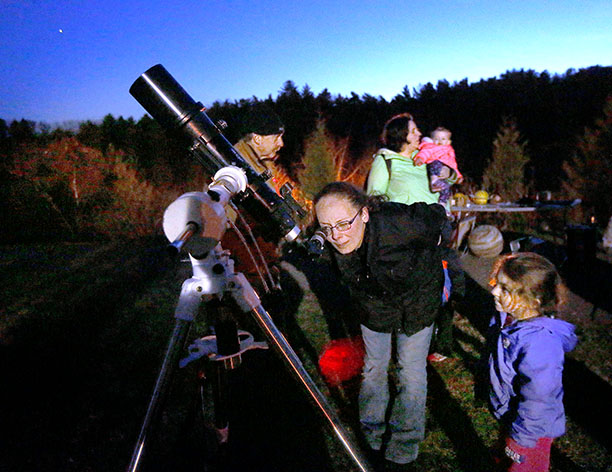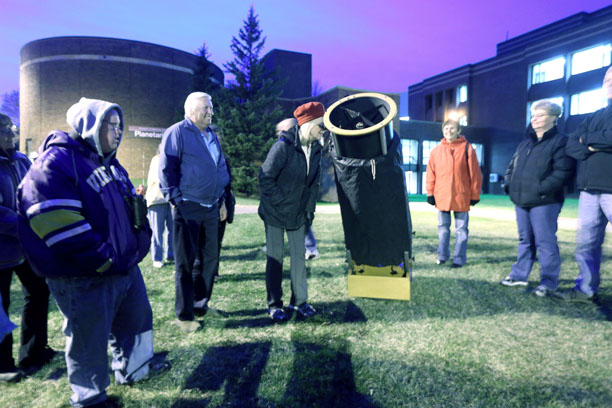Tips for a Successful Star Party
Planning a sidewalk stargazing event? Here are a few suggestions to make sure people walk away smiling.

Everybody loves looking through a telescope, including this young participant during a recent Astronomy Day.
Bob King
Bob King
I've taught community education astronomy in Duluth, Minnesota, for years and continue to be amazed at how stalwart people are when it comes to waiting their turn at the telescope on chilly nights. We always go out to observe after class no matter the weather, provided the sky is clear.
But resistance to cold or tolerance for mosquitoes only goes so far. Even Duluth skywatchers have their breaking point, so it's important to key in on bright, showy objects that easily reveal their charms to neophyte observers. For this reason I always chose the largest scope for the job to make the faint stuff as bright and easy to see as possible.
My job is an easy one if the Moon or a bright planet lights up the sky. In that case, it doesn't hurt to brush up on the names and sizes of prominent craters and other interesting lunar facts in advance. If you do your homework, you can impart a few essential nuggets of information to help those in line make the most of their minute at the eyepiece.
Only a minute? It seems much too short a time, but most people only gaze at an astronomical object for about 20 seconds, barely enough time to see anything! Whether it's out of politeness for the next in line, a brief attention span or something else, I always encourage people to take a minute and soak in the view as they might a painting by Picasso. Once they see the boldest features like Jupiter's two "stripes," I'll challenge them to the Great Red Spot (if present) or ask if they can tell that the planet is out of round.
Every detail visible becomes a learning opportunity involving the real thing rather than an image on a PowerPoint presentation. Just be careful to not go textbook on your audience. Leave them with a couple key concepts they'll remember and keep that line moving.

Parents and kids look at Jupiter through one of our local astronomy club telescopes during a recent Earth Day public stargazing event at the Lake Superior Zoo in Duluth, Minnesota
Bob King
Bob King
Point to the Planets
When it comes to planets, if Jupiter or Saturn are visible, you're in luck. Saturn's rings never fail to amaze and newcomers love seeing the moons of both. It's a good idea to check beforehand with Sky & Telescope's Jupiter's Moons and Saturn's Moons to sort which moon is which. When you can name them, those little points of light become real places.
Venus and Mercury delight with their phases. Since Uranus and Neptune present so few details, I play a little game of guess-the-planet's-color. We compare notes and then discuss how atmospheric gases affect these planets' appearance.

This summer will be perfect for hosting an all-solar system star party. Pick a night in June when all three bright planets are simultaneously visible along with a crescent or half Moon (June 8–12 is ideal). From left: Jupiter on April 18th, Saturn on April 2nd, and Mars on April 15th. South is up.
Paul Maxson
Paul Maxson
Mars is almost always too small to see very much, but it retains an allure that overcomes its visual deficiencies. Even in so-so seeing, no one ever seems disappointed to get their first look at the Red Planet. With opposition less than a month away, and Saturn's to follow in early June, a telescopic visit to all three would make a perfect opportunity for a public gathering. Throw in a crescent or half Moon, and you'll have your hands full.
Go Clubbing
Although I've done many solo astro outings, club events add an extra dimension of fun as well as take the pressure off a single observer. Each scope can specialize on a particular object, allowing attendees to get a taste of each without having to wait for everyone to see the one object before moving on to the next.
Often, while the line works its way past the eyepiece, I'll pull out a green laser and point out the brighter constellations. Once people start looking up, all those eyes catch many things that one set can easily miss. I get great satisfaction when someone shouts out that they've sighted a satellite, a meteor, or the start of a northern lights display. People love finding things on their own. Indeed this is how so many of us made our own first connection to the night sky. Discovery. It's potent stuff, so be sure to spend part of every observing session just looking up with the group.
After they get a taste of old-fashioned constellation hunting, surprise them by popping out your phone and demonstrating the power of some of the new sky apps for finding planets, stars and satellites. Many are free. I've listed a couple examples at the end of the article.
Some in your group will have to leave early. Always thank them for coming and make sure to give them a slip of paper with the names of both an Android and iPhone night sky / stargazing app and the websites where they can be downloaded. Of course, you will have thought of this in advance and have them ready for all your guests. Since nearly everyone has a smartphone, they can use the app to continue the journey of self-discovery on their own.
Proper Prep Makes the Star Party
Like I said earlier, when the planets and Moon are out, our job as night-sky tour guides is ever so much easier. Since that's not always the case, it's best to prepare a cosmic sampler that includes a bright representative of each major class of deep-sky object: open cluster, globular cluster, nebula, double star, and galaxy high enough in the sky for a great view. To that end, I've prepared two lists you might find helpful, one for the current season and another for summer.
If a bright gibbous or full Moon is out, I limit the session to the Moon, bright double stars, and bright open clusters. No sense explaining what they should be seeing when it's swamped by moonlight!
Your choices may (and probably will!) only partially overlap mine. Take these as a starting point:
Spring Season
- Planet: Jupiter is beautifully placed for viewing all this spring. #1 on the list! Be alert for shadow transits and eclipses of its moons that may occur during your outing. The shadows of Ganymede, Io, and Callisto are easiest to see for beginners.
- Open cluster: M35 in Gemini / M37 in Auriga in early spring. Late spring, try M67 in Cancer.
- Nebula: NGC 2392, a planetary nebula in Gemini. Great to use as a crystal ball to gaze into the Sun's far future.
- Globular cluster: M3 in Canes Venatici. I use low power for many objects but not globulars. For impact, 150×-200× is best.
- Double star: either Mizar-Alcor in the Big Dipper / Alpha (Cor Caroli) in Canes Venatici / Iota Cancri.
- Red star: Star colors are often pale but certaincarbon stars have striking, smoky red hues. These little gems always elicit "wows!" Try V Hydrae(currently ~8.6 magnitude). Click for a chart.
- Galaxy: M51, the Whirlpool. One of the few galaxies that when high enough and viewed in a 10-inch or larger telescope reveals hints of spiral structure to a beginner. The M81–82 duo in UMa makes a great low-power pair that sweetly illustrates the difference between open and edge-on galaxies. If you're just looking for just a single bright galaxy, stop by either M94 (magnitude +8.9) or M63 (+9.3), both in Canes Venatici and easy to find. Their concentrated cores stands out well against their outer disks, making either a good choice for explaining basic galactic structure.

Students in a community education astronomy class look at planets through a 15-inch reflector. Outings with the newcomers to astronomy make for an equal mix of inspiration, philosophical reflection, and good humor. In short, they're a blast.
Bob King
Bob King
Summer Season
- Planets: Take your pick — Jupiter, Mars and Saturn! Jupiter will leave the scene in July.
- Open cluster: M11, the Wild Duck Cluster.
- Nebula: M57, the Ring Nebula / M8, the Lagoon Nebula in Sagittarius, or the Veil Nebula in Cygnus. Use a nebular filter on both the Veil and M8 to enhance contrast and detail.
- Globular cluster: M13, the Great Globular in Hercules / M22 in Sagittarius / M5 in Serpens
- Double star: Beta Cygni (Albireo) / Beta Scorpii / Epsilon-1 and Epsilon-2 Lyrae, the "Double Double"
- Red star: T Lyrae. Click for a chart.
- Galaxy: M106 in UMa. Bright and big!
Always check for passes of the International Space Station (ISS) either at NASA's Spotthestation or onHeavens Above. Beginning skywatchers are delighted to know they can see the space station so easily. Watching it glide across the sky or suddenly disappear into Earth's shadow elicits a certain primal excitement.
Finally, when everyone else has gone home, a small, hardcore group will often remain. For these folks I keep an expanded list that includes more challenging objects: a bright quasar such as 3C273, currently well-placed in Virgo, additional galaxies, a planetary nebula, a close double star, and perhaps a comet.
When someone utters "wow!" at their first sight of a star cluster, I'm always reminded that sharing the sky works both ways. We help our guests expand their cosmic perspective, they help us enlarge our human one.

No comments:
Post a Comment